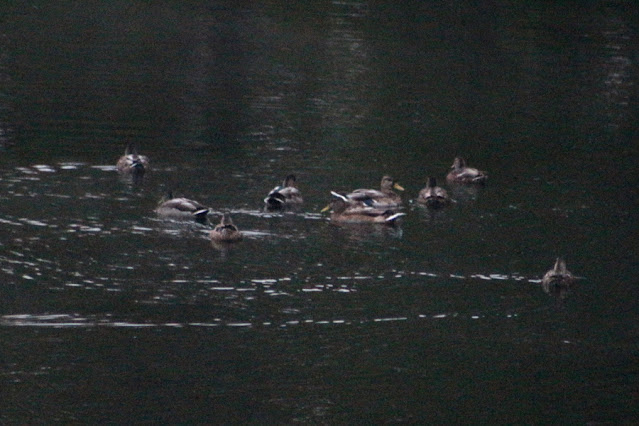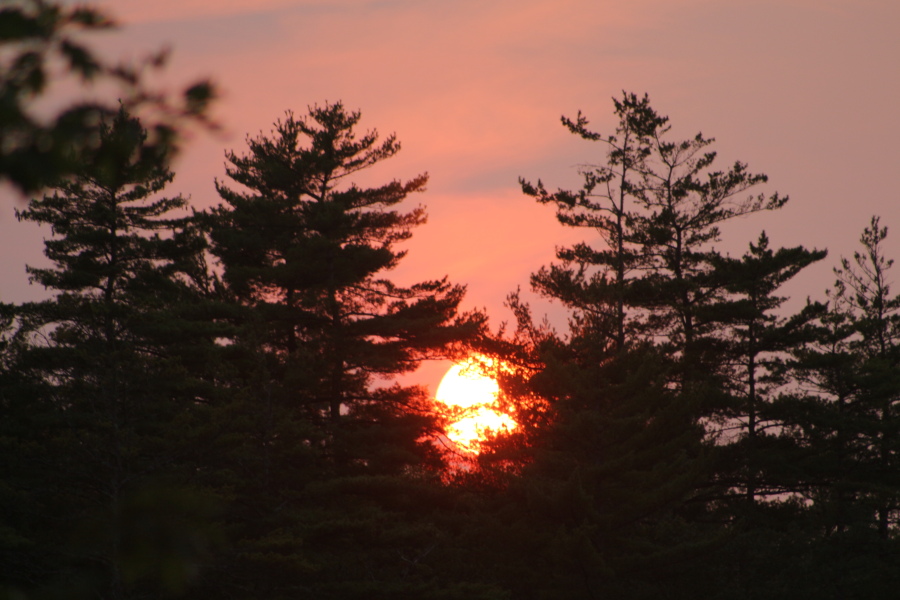Yes, those are California's forests blowing over us at 25,000 feet. The fires in California, Oregon, and Colorado are making their presence known here in New England via smoke being transported 3000 miles in the jet stream. The fine particles in the air absorb and reflect the shorter wavelengths of light, leaving only red to penetrate the atmosphere at sunset.
 |
| That's the sun on September 16th. (No filter) |
A clear day - evident by long visibility at ground level - should provide us a beautiful blue sky but instead paints a uniformly gray background behind the mountains due to the smoke at higher levels in the atmosphere.
 |
| Mount Lafayette, 40 miles away, was clearly visible from the White Mountain Ledge. |
Here in New Hampshire we're experiencing a serious drought and our local fire danger is also very high, especially with the strong, dry winds, but it's nothing compared to the diametrically opposed weather problems in the gulf states and the west.
There's a lot going on around the lakes right now as summer transitions over to autumn - the autumnal equinox occurs this Tuesday at 9:30am - and changes are happening quickly. Almost on cue, we had the first frost just this morning. I'll cover as much as I can in a rapid fire manner.
It's impressive how well some of our wildflowers can flourish even in a dry summer. The goldenrod and asters somehow adapt to the conditions and are just as beautiful as ever.
 |
| Heath Asters, Calico Asters, and Goldenrod share the stage. |
I don't ever remember seeing the stream at the entrance to the Hamlin Trails completely dry.
 |
| A bridge over troubled water. |
It will be interesting to see how the trees and the fall foliage handle the drought.
Today's frost was limited to open areas with good sky exposure for radiational cooling, and away from the lake, as the warm water kept areas near the lake several degrees warmer than just a few hundred feet distant.
 |
| First frost: September 20, 2020 |
Even with the drought the mushrooms are fruiting, though not as abundantly as usual.
 |
| A trio of Amanita mushrooms. (Note the green oak gall photo-bombing the picture.) |
This is easier to understand when I remember that a mushroom is the fruit of a huge fungus than can spread underground over a very large area so it has a wide domain from which to collect moisture.
With cooler weather the animals seem to be more active. I've seen several deer in the neighborhood the past couple of weeks, including this one in a field, trying to decide if it needs to worry about me or can just ignore me.
It did take a few bounds, stop and look again, then repeated the process until it decided it was safe.
Other signs of animals on the move are evident by their scat. These two calling cards were found on a walk near Rattlesnake Mountain in Sandwich.
 |
| A good size pile of bear scat. |
 |
| And an even larger pile from a moose. |
Smaller animals are on the move too, including turkeys. I've seen large flocks all around the region, including a multi-family unit of 19 crossing Livingstone Road just west of Meredith Center. On a trip through the town of Hill last week I had to stop for another large flock crossing in front of me, and when I did, some of the poults decided it was a nice place to plop down for a rest.
 |
| Murray Hill Road in Hill. |
I might think it was because the road was warm, but this was before 8:00 in the morning, so that wasn't the attraction.
Lots of early-migrating ducks have been paddling around in the lake.
 |
| The early morning wake-up call. |
I see large groups early in the morning, while later in the day they seem to break up into pairs and smaller groups.
Our loon family, however, hasn't gone anywhere yet.
 |
| Harold or Betty, looking quite mature on a crisp fall day. |
Harold and Betty are still here, as are both parents. If there was only one chick it's likely the male would have left by now, but with two chicks to feed he is still helping out. But in the next few weeks both parents should be departing, leaving the chicks to fend for themselves into November before they also head to the ocean for the winter.
I wonder if they notice the changes in the sky.



No comments:
Post a Comment